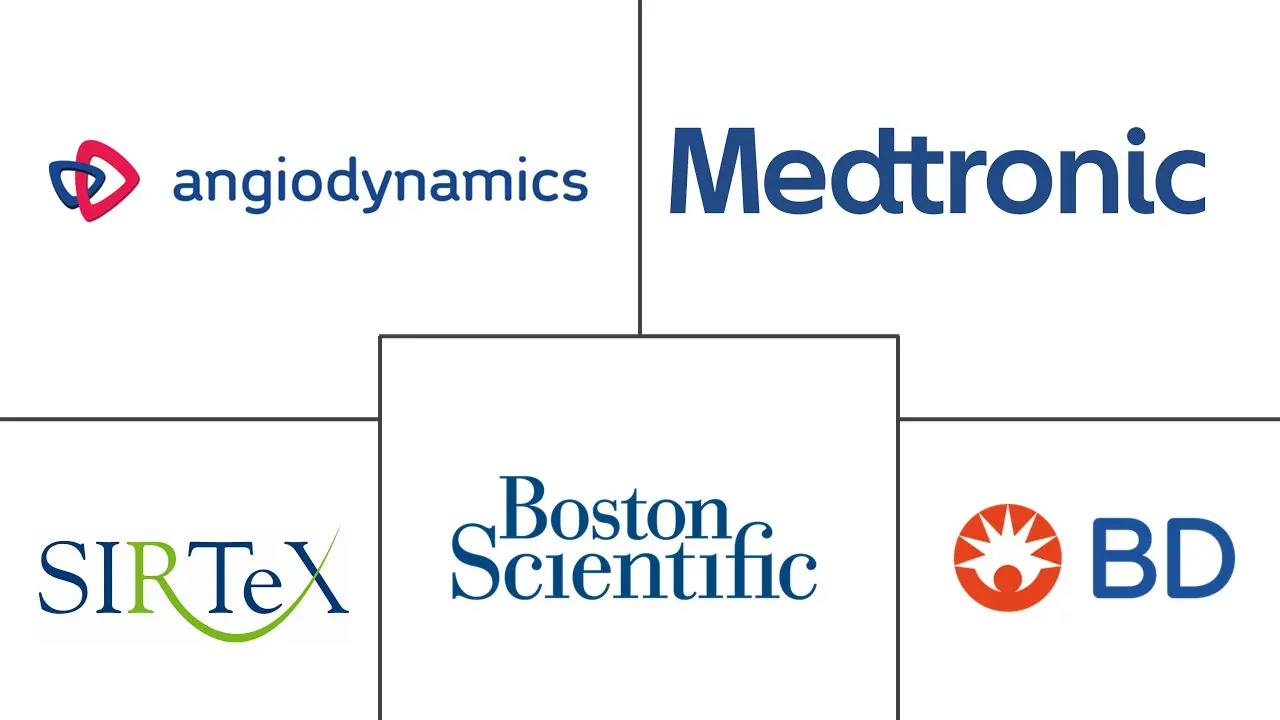Interventional Oncology Devices Market Size and Share
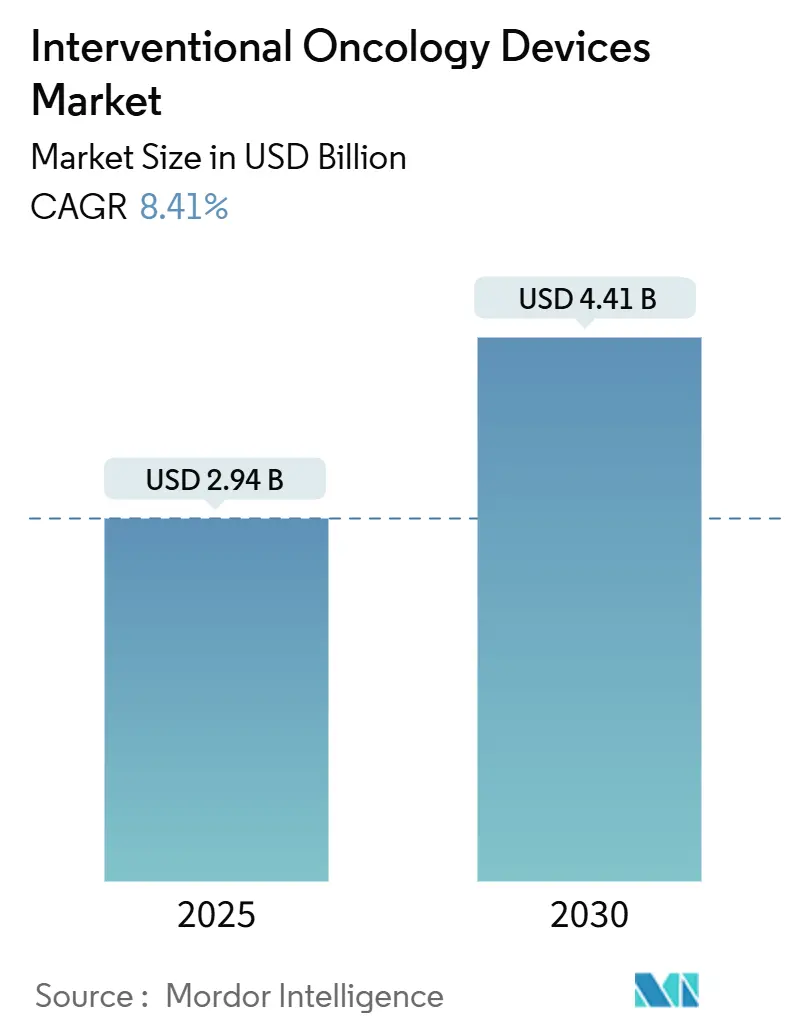
Interventional Oncology Devices Market Analysis by Mordor Intelligence
The interventional oncology devices market was valued at USD 2.94 billion in 2025 and is forecast to reach USD 4.41 billion by 2030, advancing at an 8.41% CAGR. Demand grows as hospitals and specialty centers adopt minimally invasive cancer therapies to address a global cancer burden of 20 million new cases in 2022. A steady stream of technological breakthroughs—AI-enabled navigation, robotic catheters and multi-modal imaging—positions interventional oncology as a midpoint between open surgery and systemic drug regimens. Liver cancer procedures remain the primary revenue driver, yet device makers are rapidly commercializing solutions for difficult organs such as the pancreas and lung. Growth prospects are reinforced by favorable payer policies in the United States and Europe, rising capital budgets across leading Asian hospitals and a widening outpatient footprint that aligns with value-based care. Moderate competitive intensity allows established suppliers to fund R&D while still leaving headroom for start-ups introducing disruptive platforms in ablation and embolization.
Key Report Takeaways
- By product type, embolization devices led with a 44.23% revenue share in 2024; ablation devices are forecast to expand at an 11.76% CAGR to 2030.
- By procedure type, embolization-only treatments held 49.56% of the interventional oncology devices market share in 2024, while combination therapies are projected to grow at an 11.46% CAGR through 2030.
- By cancer type, liver applications commanded 44.71% of the interventional oncology devices market size in 2024; pancreatic procedures are advancing at a 12.03% CAGR between 2025-2030.
- By end user, hospitals captured 61.22% of demand in 2024; ambulatory surgical centers represent the fastest-rising setting at an 11.23% CAGR to 2030.
- By geography, North America accounted for 38.46% revenue in 2024, while Asia-Pacific is set to post the quickest growth at a 10.88% CAGR through 2030.
Global Interventional Oncology Devices Market Trends and Insights
Drivers Impact Analysis
| Driver | (~) % Impact on CAGR Forecast | Geographic Relevance | Impact Timeline |
|---|---|---|---|
| Rising burden of cancer | +2.1% | Global; highest in Asia-Pacific and Sub-Saharan Africa | Long term (≥ 4 years) |
| Demand for minimally invasive therapies | +1.8% | North America and EU leading; expanding to Asia-Pacific | Medium term (2-4 years) |
| Advancements in image-guided ablation & embolization | +1.5% | Global; early adoption in developed markets | Medium term (2-4 years) |
| Favourable reimbursement & clinical guidelines | +1.2% | North America & EU primarily; selective Asia-Pacific | Short term (≤ 2 years) |
| AI-enabled navigation & robotic assistance | +1.0% | North America & EU core; spill-over to Asia-Pacific | Long term (≥ 4 years) |
| Growing palliative-care demand | +0.9% | Global; emphasis on aging populations | Long term (≥ 4 years) |
| Source: Mordor Intelligence | |||
Rising Burden of Cancer
Global cancer cases are projected to climb 77% to 35 million by 2050, driven by aging and lifestyle changes.[1]American Cancer Society, “Cancer Cases Expected to Rise to 35 Million Worldwide by 2050,” cancer.org Health systems in lower-income nations face disproportionately high mortality, prompting interest in portable embolization kits and battery-powered ablation generators. Hepatocellular carcinoma remains the largest target for trans-arterial chemoembolization, while clinical trials reveal that pairing lenvatinib with locoregional therapy extends survival. Consequently, the interventional oncology devices market continues to shift from niche adoption toward mainstream cancer-care algorithms.
Surge in Demand for Minimally Invasive Therapies
Value-based payment models reward shorter hospital stays, encouraging clinicians to favor catheter-based tumor treatments over open surgery. FDA clearance of histotripsy in 2024 showed 85-95% liver-tumor response and same-day discharge potential. Laser-guided microwave ablation trims procedure time by 10% versus freehand placement. Hospitals also reduce capital bottlenecks by running ablations in outpatient suites, widening access and lowering cost of care.
Advancements in Image-Guided Ablation & Embolization Platforms
AI-driven cone-beam CT removes calcified bone to clarify vessels, cutting fluoroscopy while preserving image quality. Augmented-reality headsets layer guidance data directly onto the anatomy, and predictive algorithms pre-compute ablation zones to improve reproducibility. Robotic systems already achieve 94% technical success in diagnostic cerebral angiography.[2]Yuya Sakakura et al., “Real-Time AI-Assisted Carotid Artery Stenting,” jnis.bmj.com
Favourable Reimbursement and Clinical Guidelines
CMS created precise CPT codes for intraosseous basivertebral nerve ablation in 2024, clarifying payment pathways.[3]Centers for Medicare & Medicaid Services, “Billing and Coding: Intraosseous Basivertebral Nerve Ablation,” cms.gov Oncology societies now list locoregional interventions alongside systemic agents for advanced hepatocellular carcinoma. Japan’s PMDA aligned its QMS rules with ISO 13485, smoothing foreign market entry. These shifts secure revenue visibility for device producers and encourage hospital investment.
Restraints Impact Analysis
| Restraint | (~) % Impact on CAGR Forecast | Geographic Relevance | Impact Timeline |
|---|---|---|---|
| Shortage of trained interventional oncologists | −1.4% | Global; acute in North America & emerging markets | Long term (≥ 4 years) |
| Stringent regulatory hurdles & recall risks | −1.1% | Global; varies by regulator | Medium term (2-4 years) |
| High capital cost of advanced equipment | −0.8% | Primarily emerging markets | Medium term (2-4 years) |
| Limited long-term data for combination regimens | −0.6% | Global | Long term (≥ 4 years) |
| Source: Mordor Intelligence | |||
Shortage of Trained Interventional Oncologists
Only 123 trainees entered U.S. interventional radiology residencies in 2023, yet more than 1,400 radiologist positions remained vacant. Immature fellowship capacity caps procedure volumes and slows rural expansion. Simulated reality labs and AI-augmented guidance partially offset the gap but cannot fully replace specialist judgment.
Stringent Regulatory Hurdles & Product-Recall Risks
FDA Class I recalls on Medtronic’s Pipeline Vantage and Boston Scientific’s Obsidio embolic products disrupted inventories in 2024-2025. Manufacturers bear heavy surveillance costs, and late adverse-event reporting remains common. Smaller innovators therefore face higher barriers to global launch.
Segment Analysis
By Product Type: Ablation Technologies Drive Innovation
Embolization devices generated 44.23% of revenue in 2024, underlining their dominance in hypervascular tumors. Conversely, the ablation category is expanding at an 11.76% CAGR, propelled by smarter microwave antennas that automatically adjust power based on tissue impedance. The interventional oncology devices market size for ablation systems is expected to reach USD 1.4 billion by 2030. Real-time thermal maps minimize collateral damage, while non-thermal approaches such as irreversible electroporation safeguard vital ducts and vessels. Navigation platforms merge CT, MRI and fluoroscopy into a single interface, transforming image guidance from passive display into active decision support. Disposable accessory uptake rises with infection-control mandates, and infection-free disposables see double-digit gains.
The convergence of imaging, navigation and energy delivery fosters integrated solutions that reduce room changeovers. Suppliers increasingly bundle embolic microspheres with delivery catheters and software licenses, improving margin capture. Regulatory approvals for AI-assisted cone-beam scans spur vendor-neutral software ecosystems, broadening choice for clinicians while widening aftermarket revenue streams. As a result, buyers shift evaluation metrics from hardware specifications to overall workflow efficiency.
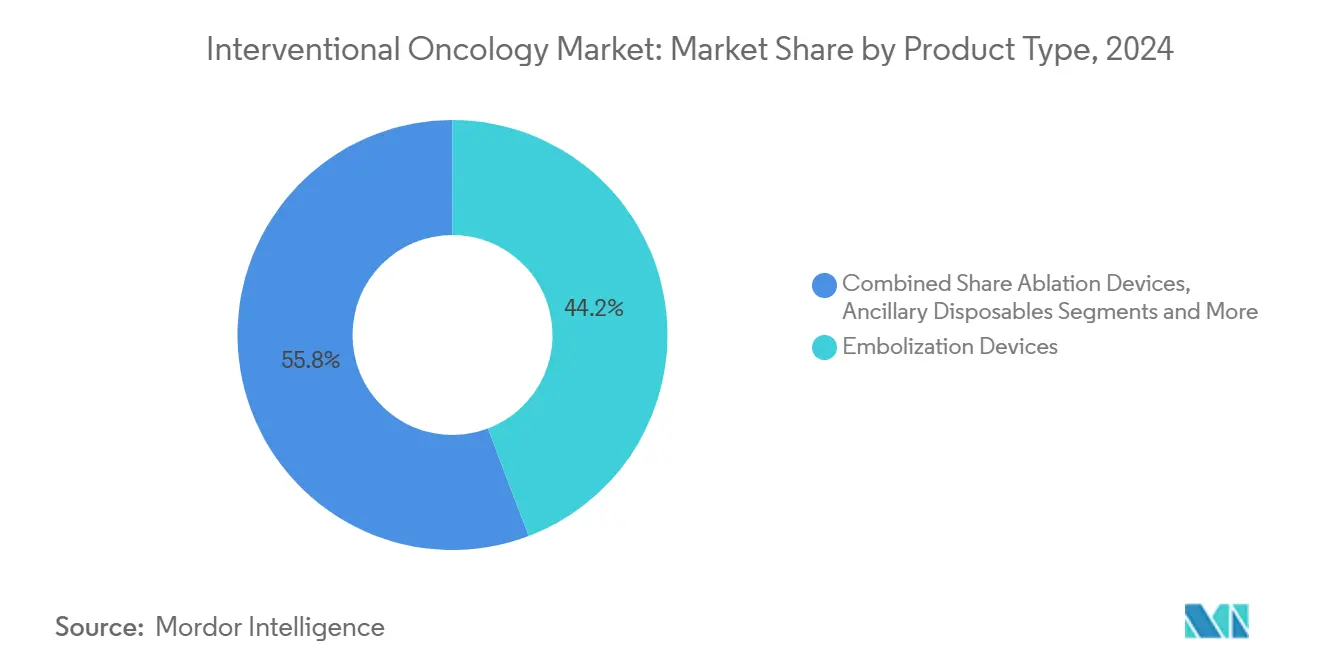
Note: Segment shares of all individual segments available upon report purchase
By Procedure Type: Combination Therapies Reshape Treatment Paradigms
Embolization-only techniques held 49.56% of 2024 procedures, mainly trans-arterial chemoembolization for hepatocellular carcinoma. Ablation-only sessions serve early-stage lung, kidney and breast lesions. Still, combination cases are the decisive growth engine, climbing 11.46% annually as trials confirm that pairing lenvatinib with TACE prolongs progression-free survival. Hospitals now schedule sequential ablation then immunotherapy within 48 hours to exploit immunogenic cell death.
Multidisciplinary tumor boards place interventional radiologists alongside medical oncologists to co-design regimens, fostering institutional learning curves. Device makers build joint-therapy kits that combine embolic beads, ablation needles and drug-eluting carriers to simplify supply chains. Though complex, these protocols boost reimbursement because payers recognize superior outcomes, making them a mainstay by decade-end.
By Cancer Type: Pancreatic Applications Signal Market Evolution
Liver cases dominated 2024 revenue at 44.71%, yet pancreatic indications, once considered off-limits, now expand at 12.03% annually. High-frequency irreversible electroporation spares surrounding vasculature, enabling a curative attempt in borderline-resectable tumors. Lung cancer interventions benefit from steerable ablation probes that reach peripheral nodules via single-access bronchoscopy. Breast cryoablation gains popularity for early-stage lesions, offering office-based alternative to lumpectomy.
Bone metastasis palliation escalates as oncology longevity rises. Cementoplasty with radiofrequency ablation relieves pain and stabilizes structure in a single sitting. The diversification across tumor types proves the interventional oncology devices market has outgrown its liver-centric roots, cementing its role in comprehensive cancer care.
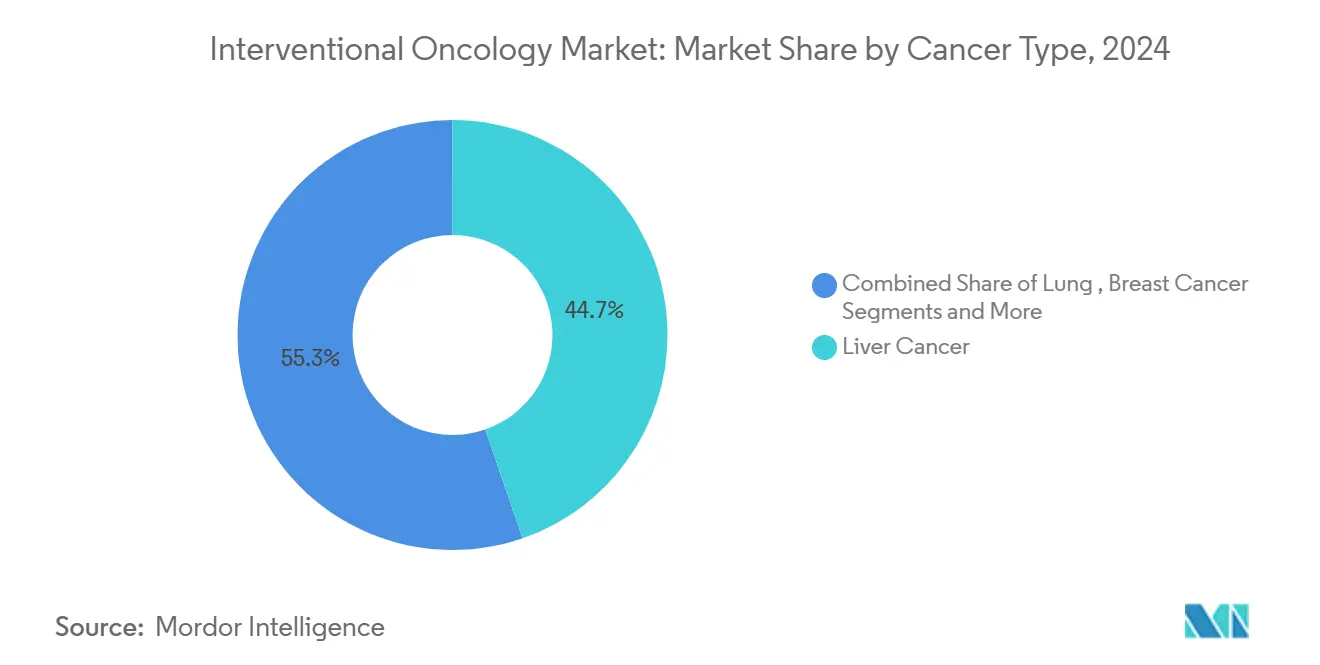
Note: Segment shares of all individual segments available upon report purchase
By End User: Ambulatory Settings Transform Care Delivery
Hospitals retained 61.22% revenue in 2024, leveraging critical-care backup and training programs. Yet ambulatory surgical centers post an 11.23% CAGR, aided by streamlined accreditation and reimbursement parity with inpatient facilities. Cancer specialty centers, often part of academic networks, pioneer early access to robotic catheters and predictive analytics. Office-based labs emerge where regulations permit, performing vein-to-port placements and small renal ablations under conscious sedation.
Payers reimburse same-day discharges at favorable rates, incentivizing outpatient migrations. Portable ultrasound and compact C-arms shrink the footprint, letting providers deploy dedicated interventional oncology suites adjacent to medical oncology clinics. The trend dovetails with patient preference for low-stress settings.
Geography Analysis
North America contributed 38.46% of 2024 revenue, underpinned by robust CPT coding and near-universal private-insurance coverage. The region hosts most device launches, with FDA 510(k) clearances like Visualase V2 laser ablation in June 2025 bolstering early uptake. Hospitals exploit bundled-payment models to justify investment in AI-guided imaging.
Europe follows with mature protocols and cross-border tele-mentoring networks that diffuse expertise into mid-tier hospitals. Strict CE-Mark evidence requirements delay initial adoption but eventually cement clinician confidence, generating steady, if incremental, growth. Country-level registries supply real-world evidence, speeding payer inclusion.
Asia-Pacific is the fastest-growing territory at a 10.88% CAGR, thanks to rising cancer incidence, national reimbursement rollouts and harmonized standards across ASEAN. China’s NMPA cleared 228 new drugs in 2024—37% oncology focused—signaling parallel enthusiasm for device innovation. Major urban hospitals in India and Indonesia open hybrid angio-CT suites, often financed through public-private partnerships. Japan’s QMS alignment simplifies imports, creating a predictable path for U.S. and European vendors.
Latin America shows uneven progress; Brazil funds tertiary cancer centers that house high-end ablation suites, whereas smaller nations rely on visiting-physician models. In the Middle East, Gulf Cooperation Council states include embolization and microwave ablation in national cancer strategies, supported by sovereign-wealth investment. Tele-consult platforms extend subspecialty guidance into rural clinics, widening patient reach without proportional infrastructure spend. Collectively, these dynamics keep the interventional oncology devices market on a global high-growth trajectory.
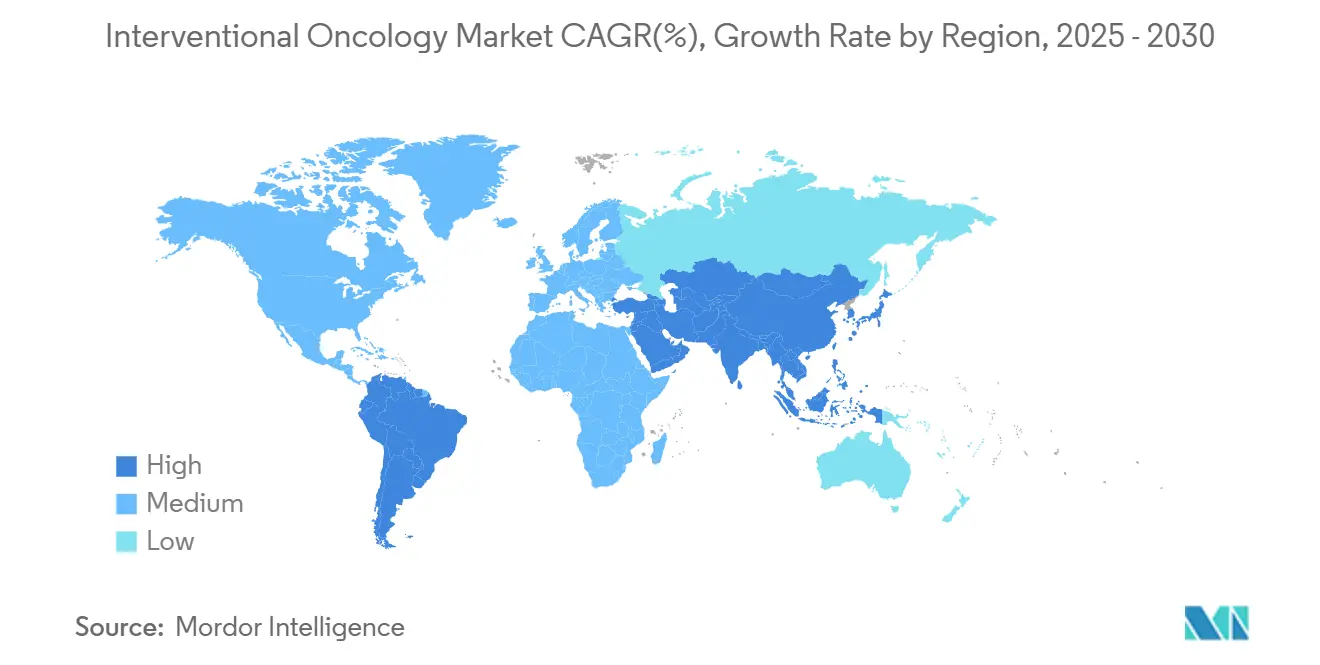
Competitive Landscape
The interventional oncology devices industry is moderately concentrated. Boston Scientific, Medtronic and Johnson & Johnson collectively held 35% of 2024 global sales. Boston Scientific’s cardiovascular and oncology unit produced USD 4.663 billion in Q1 2025 revenue, buoyed by its Obsidio embolic lineup. Medtronic’s advanced ablation portfolio delivered USD 1 billion in FY25, up nearly 30% year-on-year, anchored by pulsed-field systems.
Strategic consolidation remains active. Stryker agreed to buy Inari Medical for USD 4.9 billion in June 2025, gaining access to peripheral thrombectomy and oncology crossover technologies. Teleflex purchased BIOTRONIK’s vascular intervention unit for €760 million, broadening its access product range. These deals show large firms hedging against single-modality dependence and seeking end-to-end procedure control.
Emerging competitors advance histotripsy, focused ultrasound and AI software modules. TriSalus Life Sciences introduced TriNav FLX, aiming to enhance drug infusions into solid tumors. Venture funding flows into start-ups developing steerable micro-catheters and energy-modulation algorithms. At the same time, recurring recalls keep compliance costs high, benefitting incumbents with mature quality systems. Overall, technology leadership and M&A agility dictate long-term positioning.
Interventional Oncology Devices Industry Leaders
-
Boston Scientific Corporation
-
Medtronic plc
-
AngioDynamics
-
Sirtex Medical
-
Becton, Dickinson & Co.
- *Disclaimer: Major Players sorted in no particular order
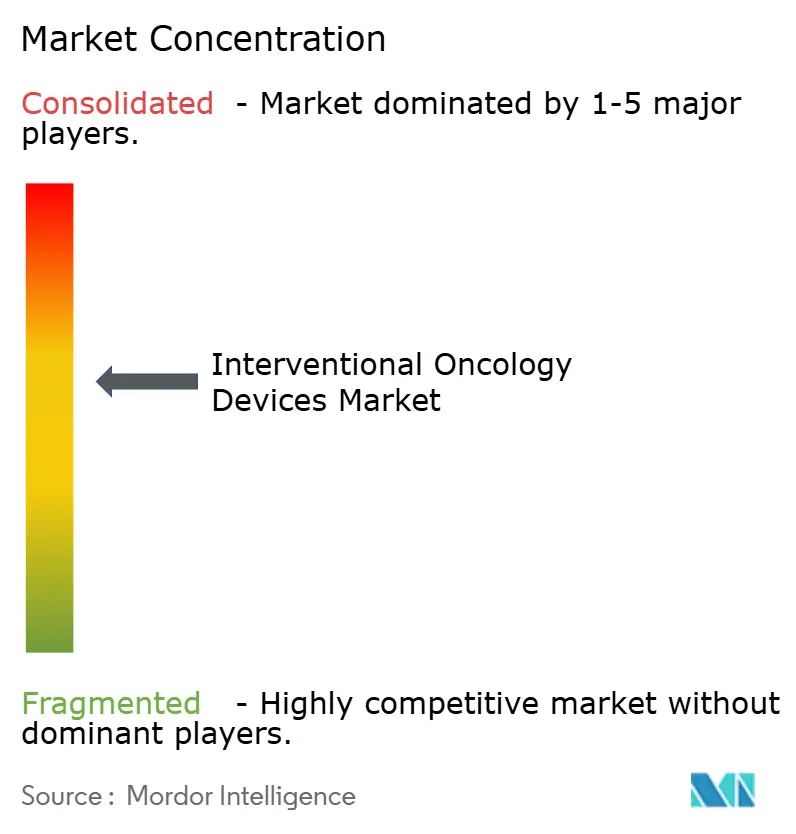
Recent Industry Developments
- June 2025: TriSalus Life Sciences launched the TriNav FLX Infusion System to enhance targeted drug delivery.
- June 2025: FDA granted 510(k) clearance for the Visualase V2 MRI-guided laser ablation platform for brain lesions.
- June 2025: FDA approved UroGen Pharma’s mitomycin solution Zusduri for recurrent low-grade bladder cancer
- May 2025: Portal Access raised USD 7 million Series A to advance vascular-access devices for oncology.
Research Methodology Framework and Report Scope
Market Definitions and Key Coverage
Our study defines the interventional oncology devices market as the value generated by image-guided ablation probes, embolic particles, and delivery catheters, navigation or imaging consoles that enable tumor-directed therapy, and the single-use disposables deployed during such minimally invasive cancer procedures performed inside angio suites or hybrid ORs. According to Mordor Intelligence, revenues are booked at manufacturer selling prices and captured worldwide before distributor mark-ups.
Scope Exclusions: Conventional external-beam radiotherapy units, systemic oncology drugs, and open surgical resection tools fall outside this analysis.
Segmentation Overview
- By Product Type
- Ablation Devices
- Thermal Ablation (Microwave, Radiofrequency)
- Non-thermal Ablation (Cryoablation, Irreversible Electroporation)
- Embolization Devices
- Embolic Agents (Bland, Chemo, Drug-eluting, Y-90)
- Delivery Accessories (Micro-catheters, Guidewires)
- Navigation & Imaging Systems
- Ancillary Disposables
- Ablation Devices
- By Procedure Type
- Ablation-only
- Embolization-only
- Combination Therapies
- By Cancer Type
- Liver
- Lung
- Breast
- Kidney
- Prostate
- Bone Metastases
- Pancreatic
- Other Cancers
- By End User
- Hospitals (Academic & Community)
- Cancer Specialty Centers
- Ambulatory Surgical & Outpatient IO Suites
- Office-based Labs
- By Geography
- North America
- United States
- Canada
- Mexico
- Europe
- Germany
- United Kingdom
- France
- Italy
- Spain
- Rest of Europe
- Asia-Pacific
- China
- Japan
- India
- Australia
- South Korea
- Rest of Asia-Pacific
- Middle East and Africa
- GCC
- South Africa
- Rest of Middle East and Africa
- South America
- Brazil
- Argentina
- Rest of South America
- North America
Detailed Research Methodology and Data Validation
Primary Research
Mordor analysts interviewed interventional radiologists, oncology surgeons, cath-lab managers, and regional group purchasing officers across North America, Europe, Asia-Pacific, and select Middle-East hubs. These conversations validated disposable usage rates, typical capital budgeting cycles, and emerging indications, allowing us to plug information gaps identified during desk work.
Desk Research
We collated baseline data from respected public sources such as the WHO-IARC GLOBOCAN registry, SEER program tables, OECD Health statistics, United States FDA 510(k) device database, and annual procedure counts published by the Cardiovascular and Interventional Radiological Society of Europe. Company filings, hospital procurement tenders, and reputed trade press articles enriched pricing and channel insights. Subscription resources, including D&B Hoovers for company financials, Dow Jones Factiva for global news flow, and Questel for ablation-related patents, helped trace competitive footprints. This list is illustrative, with further databases referenced whenever clarification was required.
Market-Sizing & Forecasting
The top-down model begins with country-level new cancer incidence, liver and lung prevalence ratios, and procedure adoption curves, which are then layered with average selling prices harvested from tender logs. Supplier roll-ups and channel checks provide a bottom-up reasonableness screen before final totals are locked. Key variables tracked include: 1) annual microwave and radiofrequency ablation installs, 2) unit prices of drug-eluting beads, 3) interventional oncology fellowship output, 4) regulatory approvals trend, and 5) imaging suite capacity utilization. We forecast using a multivariate regression that links these drivers with macro indicators such as healthcare spending and oncology bed additions, producing base, optimistic, and caution scenarios reviewed with our primary experts.
Data Validation & Update Cycle
Outputs pass variance checks against historical procedure growth, abnormal ASP swings, and independent shipment statistics. Senior analysts re-review anomalies before sign-off. Reports refresh each year, with mid-cycle updates triggered by material recalls, reimbursement shifts, or blockbuster approvals, ensuring clients always receive the latest vetted view.
Why Mordor's Interventional Oncology Devices Baseline Remain Dependable
Published estimates often diverge; definitions differ, assumptions vary, and refresh cadences range from annual to biennial.
Key gap drivers include product scope, the share of navigation consoles counted as oncology spend, differing ASP progression methods, and whether recurrent disposable revenue is annualized or treated as one-time. Mordor's model captures the full therapy stack, adopts balanced price-volume curves vetted by clinicians, and updates every twelve months, which many peers do not.
Benchmark comparison
| Market Size | Anonymized source | Primary gap driver |
|---|---|---|
| USD 2.94 B (2025) | Mordor Intelligence | |
| USD 2.70 B (2024) | Global Consultancy A | Excludes navigation systems and applies straight-line growth without procedure validation |
| USD 2.39 B (2024) | Trade Journal B | Relies solely on prevalence data and ignores regional ASP dispersion and tender lags |
In sum, our disciplined scope selection, variable tracking, and timely refresh make Mordor Intelligence's baseline a balanced, transparent reference that decision-makers can trace back to clear real-world signals.
Key Questions Answered in the Report
1. What is the current value of the interventional oncology devices market?
The market stands at USD 2.94 billion in 2025 and is projected to reach USD 4.41 billion by 2030.
2. Which product segment shows the fastest growth?
Ablation devices are expanding at an 11.76% CAGR through 2030 as hospitals embrace advanced thermal and non-thermal technologies.
3. Why are combination therapies gaining traction in interventional oncology?
Clinical studies indicate that combining locoregional procedures with systemic drugs enhances survival compared with single-modality treatment, driving an 11.46% CAGR for combination protocols.
4. Which region will grow fastest over the forecast period?
Asia-Pacific leads with a 10.88% CAGR due to rising cancer incidence, infrastructure expansion and regulatory harmonization.ality treatment, driving an 11.46% CAGR for combination protocols.
5. What are the main challenges facing device manufacturers?
Key obstacles include a shortage of trained specialists, stringent regulatory scrutiny resulting in recalls and the high capital cost of advanced imaging and ablation systems.
Page last updated on:
